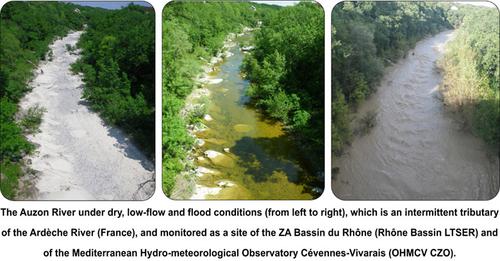当前位置:
X-MOL 学术
›
WIREs Water
›
论文详情
Our official English website, www.x-mol.net, welcomes your
feedback! (Note: you will need to create a separate account there.)
Intermittent rivers and ephemeral streams: Perspectives for critical zone science and research on socio-ecosystems
WIREs Water ( IF 6.8 ) Pub Date : 2021-05-04 , DOI: 10.1002/wat2.1523 Ophelie Fovet 1 , Axel Belemtougri 2, 3 , Laurie Boithias 4 , Isabelle Braud 5 , Jean‐Baptiste Charlier 6 , Marylise Cottet 7 , Kevin Daudin 8 , Guillaume Dramais 5 , Agnès Ducharne 3 , Nathalie Folton 9 , Manuela Grippa 4 , Basile Hector 10 , Sylvain Kuppel 5, 11 , Jérôme Le Coz 5 , Luc Legal 12 , Philippe Martin 13 , Florentina Moatar 5 , Jérôme Molénat 14 , Anne Probst 12 , Jean Riotte 4 , Jean‐Philippe Vidal 5 , Fabrice Vinatier 14 , Thibault Datry 5, 15
WIREs Water ( IF 6.8 ) Pub Date : 2021-05-04 , DOI: 10.1002/wat2.1523 Ophelie Fovet 1 , Axel Belemtougri 2, 3 , Laurie Boithias 4 , Isabelle Braud 5 , Jean‐Baptiste Charlier 6 , Marylise Cottet 7 , Kevin Daudin 8 , Guillaume Dramais 5 , Agnès Ducharne 3 , Nathalie Folton 9 , Manuela Grippa 4 , Basile Hector 10 , Sylvain Kuppel 5, 11 , Jérôme Le Coz 5 , Luc Legal 12 , Philippe Martin 13 , Florentina Moatar 5 , Jérôme Molénat 14 , Anne Probst 12 , Jean Riotte 4 , Jean‐Philippe Vidal 5 , Fabrice Vinatier 14 , Thibault Datry 5, 15
Affiliation

|
Intermittent rivers and ephemeral streams (IRES) are now recognized to support specific freshwater biodiversity and ecosystem services and represent approximately half of the global river network, a fraction that is likely to increase in the context of global changes. Despite large research efforts on IRES during the past few decades, there is a need for developing a systemic approach to IRES that considers their hydrological, hydrogeological, hydraulic, ecological, and biogeochemical properties and processes, as well as their interactions with human societies. Thus, we assert that the interdisciplinary approach to ecosystem research promoted by critical zone sciences and socio-ecology is relevant. These approaches rely on infrastructure—Critical Zone Observatories (CZO) and Long-Term Socio-Ecological Research (LTSER) platforms—that are representative of the diversity of IRES (e.g., among climates or types of geology. We illustrate this within the French CZO and LTSER, including their diversity as socio-ecosystems, and detail human interactions with IRES. These networks are also specialized in the long-term observations required to detect and measure ecosystem responses of IRES to climate and human forcings despite the delay and buffering effects within ecosystems. The CZO and LTSER platforms also support development of innovative techniques and data analysis methods that can improve characterization of IRES, in particular for monitoring flow regimes, groundwater-surface water flow, or water biogeochemistry during rewetting. We provide scientific and methodological perspectives for which this interdisciplinary approach and its associated infrastructure would provide relevant and original insights that would help fill knowledge gaps about IRES.
中文翻译:

断断续续的河流和短暂的溪流:社会生态系统临界区科学和研究的前景
间歇性河流和短暂河流 (IRES) 现在被认为支持特定的淡水生物多样性和生态系统服务,约占全球河流网络的一半,在全球变化的背景下,这一比例可能会增加。尽管在过去几十年中对 IRES 进行了大量研究,但仍需要开发一种系统的 IRES 方法,以考虑它们的水文、水文地质、水力、生态和生物地球化学特性和过程,以及它们与人类社会的相互作用。因此,我们断言,由临界区科学和社会生态学推动的生态系统研究的跨学科方法是相关的。
更新日期:2021-06-04
中文翻译:

断断续续的河流和短暂的溪流:社会生态系统临界区科学和研究的前景
间歇性河流和短暂河流 (IRES) 现在被认为支持特定的淡水生物多样性和生态系统服务,约占全球河流网络的一半,在全球变化的背景下,这一比例可能会增加。尽管在过去几十年中对 IRES 进行了大量研究,但仍需要开发一种系统的 IRES 方法,以考虑它们的水文、水文地质、水力、生态和生物地球化学特性和过程,以及它们与人类社会的相互作用。因此,我们断言,由临界区科学和社会生态学推动的生态系统研究的跨学科方法是相关的。











































 京公网安备 11010802027423号
京公网安备 11010802027423号